The ultimate guide on how to make meringue! Egg whites, sugar, salt and cream of tartar transform into meringue that is both irresistibly crispy and melt in your mouth – a real treat!
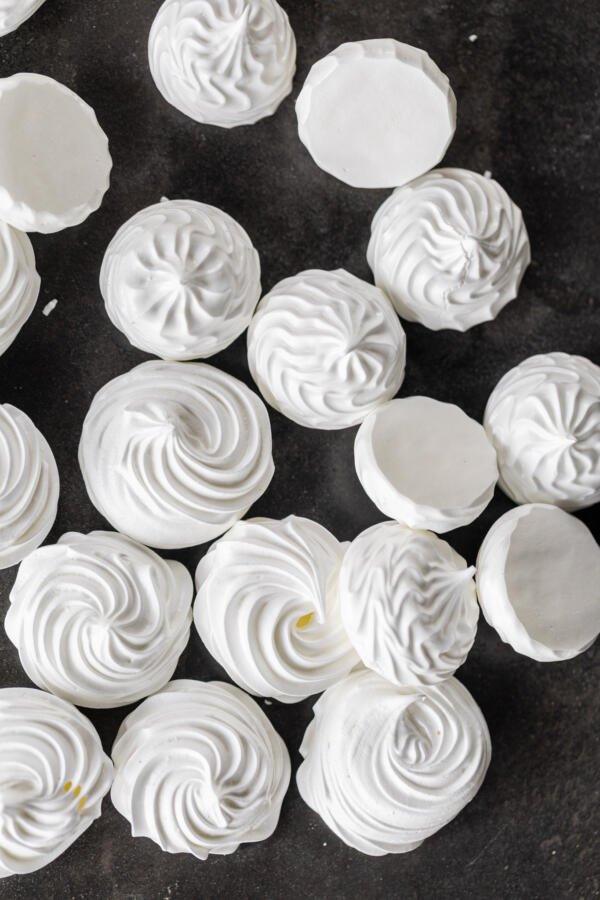
Love meringue desserts? Take a look at our peppermint meringue cookies and chocolate nut meringue cookies.
What is Meringue?
Meringue is a light and crispy dessert made from whipped egg whites and sugar. The silky smooth, shiny meringue transforms into a crunchy treat once baked, creating a wonderful textural experience. It’s often incorporated into other desserts such as lemon meringue pie, pavlova, cakes, and cookies! We use it in several cookie recipes, as well as in the traditional Ukrainian Kyiv cake, and the English classic- Eton mess.
There are three types of meringue: French, Italian, and Swiss. They all use similar ingredients- sugar and egg whites- but the preparation methods differ. If you’re wondering how to make meringue the easiest way, you’re in luck! This recipe follows the simplest of methods (the French method) as there is no heating of the eggs or sugar. Meringue can be further flavored with extracts, depending on how you plan to use it. The meringue is then either piped into cookies or morsel shapes, baked in one layer (like for a pavlova or Kyiv cake), or spread as a topping- it’s so versatile!
How To Make Meringue
This four-ingredient meringue recipe requires only a stand mixer and a bit of time. The hardest part is waiting for the meringue to bake low and slow — but your patience will pay off!
- Beat the eggs and sugar together: Using a stand mixer with the whisk attachment, beat together the egg whites and sugar on high speed until the mixture becomes foamy.
- Add the salt and cream of tartar: Add in the salt and cream of tartar.
- Whisk the meringue to stiff peaks: Beat until the meringue reaches stiff peaks — about 10 minutes.
- Prepare the oven and pan: Line a baking sheet with parchment paper and preheat the oven to 200°F.
- Pipe the meringue: Spoon the meringue into a piping bag. Pipe out two-inch sized rounds onto the baking sheet.
- Bake the cookies: Bake the cookies for about an hour and a half. Remove the cookies from the oven and allow them to cool and harden at room temperature. Enjoy!
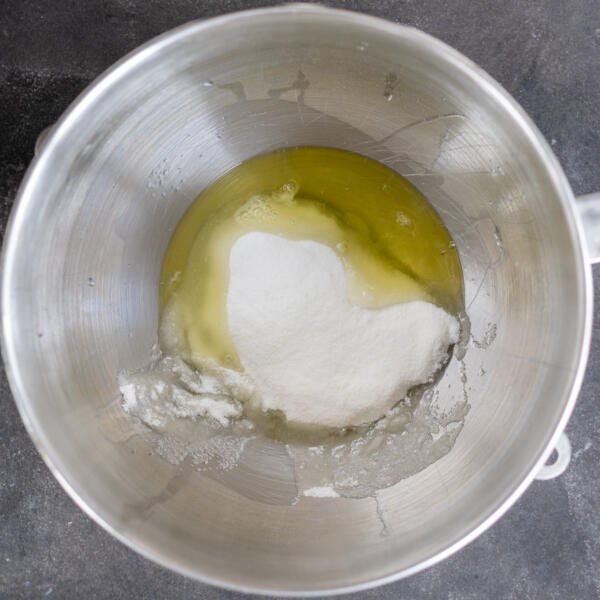
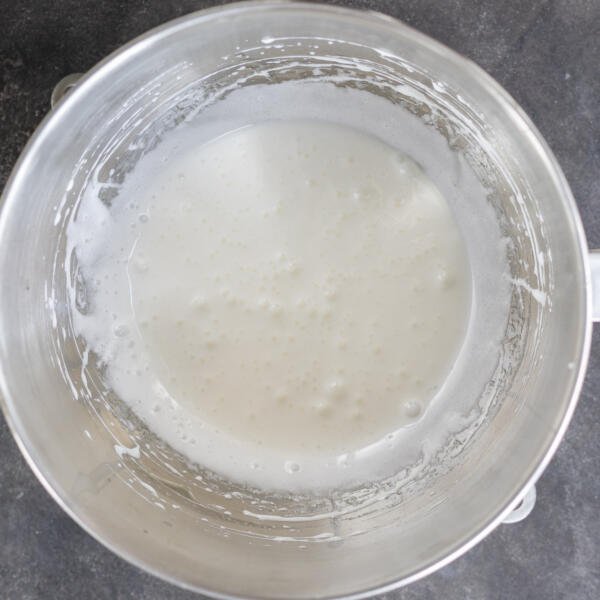

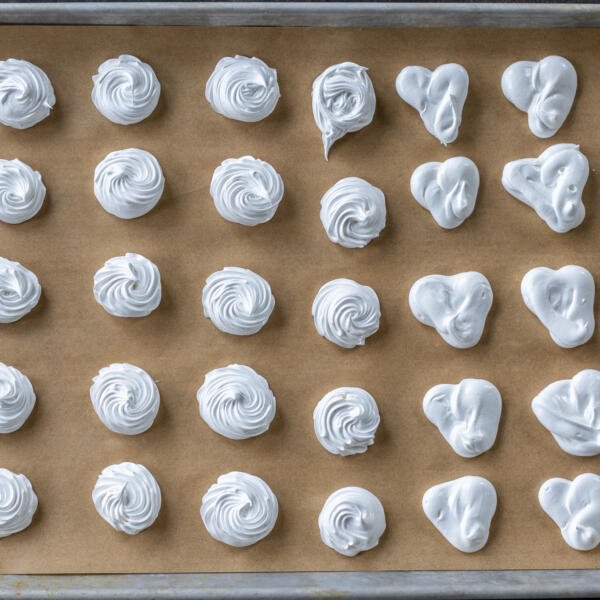
Hot tip: No stand mixer? No problem! Use an high-speed electric hand mixer like this one — but keep in mind it may take longer.
Flavor Variations
Do you want to add a flavorful twist to your meringue? Good news — this recipe is the perfect base to experiment with different flavors! Here are several ideas to get you started.
- Vanilla: Add one teaspoon of vanilla extract or vanilla bean paste for a subtly sweet flavor.
- Peppermint: Get in the holiday spirit with 1/2 teaspoon of pure peppermint extract. Swirl red food coloring through the meringue for a candy cane effect.
- Coffee: For a bold wake-up call, sprinkle one tablespoon of instant espresso powder into the meringue.
- Lemon: Add one teaspoon of lemon extract or lemon zest for a citrusy taste.
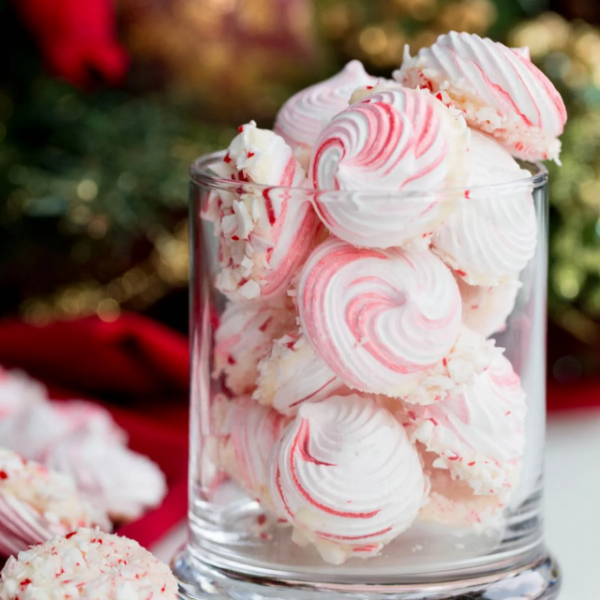
Design Ideas
Here’s where the fun begins! The options are endless when it comes to piping out meringue. We went with the cookie route when piping, but the options are nearly endless! Let’s take a look at a few different designs and their corresponding piping tips.
- Stars: Use a regular star tip or Wilton 1M or 4B to create a star design. Hold the piping bag about one inch from the parchment paper and gently squeeze from the top of the bag until you’re satisfied with the shape and size of the cookie.
- Roses: Get fancy with rosette meringue cookies by using a Wilton 1M tip. Start in the center, then pipe in a circle until you achieve a rose shape.
- Kisses: Attach a Wilton 1B tip (or open star tip) and pipe a circle of meringue, gently pulling up until the meringue breaks off to create a kiss shape.
- Hearts: Celebrate love by piping hearts with a simple round tip or Wilton 1A. Pipe one diagonal line, then an opposite diagonal line joining at the bottom to form a heart.
- Nests: Use the meringue as a pavlova base by piping a round shape (with whatever tip you prefer), then indenting the middle with a spoon to form a nest.
Hot tip: Buy a decorating kit like this one to get all the piping tips you could ever or want!

Tips For Foolproof Meringue
Meringue is notoriously tricky to master. Follow these tips to nail down your technique and produce perfect meringue.
- Use room temperature egg whites. Why should you use room temperature whites? They whip up faster — and who doesn’t appreciate a time-saving hack?
- Separate the whites and yolks off to the side. This is a safeguard to prevent a ruined meringue. Any amount of egg yolk inhibits the whites from reaching stiff peaks, so separate the eggs over a different bowl than the one you’ll use for mixing to ensure success.
- Wipe the bowl clean. Any residue of grease or moisture may prevent the meringue from whipping properly. Lightly dampen a paper towel with white vinegar and wipe the bowl thoroughly to clean it. Allow the bowl to dry, then get to whipping.
- Be patient. Reaching stiff peaks usually takes 8-10 minutes with a high-speed mixer. Under-whipped meringue will not produce detailed, puffed cookies — so take a seat and get comfortable. Don’t go too far, though! Keep an eye out so the meringue doesn’t overwhip and dry out.
- Cool the meringue completely. The cooling period is critical to crisping up the meringues. The longer they sit out after baking, the firmer they become.
Troubleshooting Meringue
Did your meringue fall short of your expectations? Keep your chin up and try, try again. Let’s discuss the most common issues you can run into so your next attempt is a success.
- Grainy: Grainy meringue is caused by undissolved sugar granules. Add the sugar a bit at a time while beating and whip the meringue to stiff peaks to ensure all the sugar dissolves. For lusciously smooth meringue, gently heat the egg white and sugar mixture over a pot of simmering water until you don’t feel any grains between your fingertips, then beat until stiff peaks form.
- Runny/Flat: Runny or flat meringue is usually just a simple case of not mixing it enough. Keep whipping the meringue until it forms a stiff peak when you lift the beater out of the bowl. You should be able to lift the bowl upside down without the meringue sliding out.
- Chewy: A chewy meringue texture is the result of improper baking techniques. Bake the cookies low and slow — at 200°F for at least an hour and a half, or until they are crisp all the way through. The stiff meringue should transform into fully dried out, light and airy cookies.
Storage
This meringue recipe will stay fresh for up to five days. Store in an airtight container at room temperature in a cool and dry place. Layer the cookies with parchment paper, since they may become sticky when exposed to the air.
Hot tip: We don’t recommend storing meringue in the refrigerator or freezer, as that increases its chances of becoming soggy.
More Meringue Recipes
- Eton Mess — A classic English treat consisting of crispy meringue, whipped cream, and strawberries
- Pavlova — A meringue base topped with cream and fresh berries
- Meringue Napoleon Cake — Crunchy meringue layered with dulce de leche cream and walnuts
- French Macarons — A foolproof macaron recipe made with almond flour, powdered sugar, and meringue
- Zefir Marshmallows — Colorful Russian homemade marshmallows
Recipe
Ingredients
- 3 egg whites room temperature
- 3/4 cup granulated sugar
- 1/8 tsp salt
- 1/4 tsp cream of tart
Instructions
- Using a stand mixer with the whisk attachment on high speed, beat the egg whites together with the sugar until the mixture becomes foamy.
- Add in the salt and cream of tartar and beat until the meringue reaches stiff peaks. This will take about 10 minutes.
- Line a baking sheet with parchment paper and preheat the oven to 200°F. Spoon the meringue into a piping bag. Pipe out 2-inch sized rounds onto the baking sheet, then bake the cookies for about 90 minutes.
- Remove the cookies from the oven and allow them to cool and harden at room temperature. Enjoy!
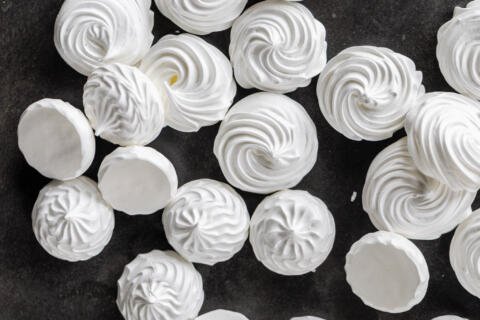
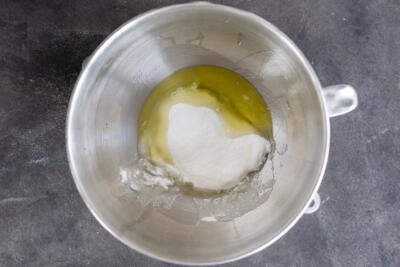

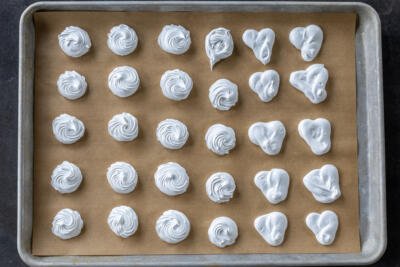
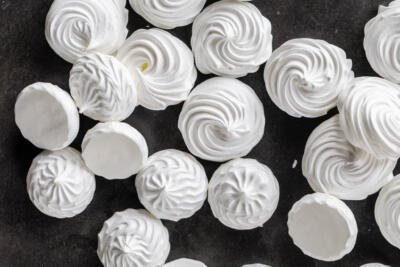


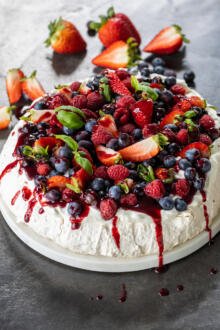



My grandma used to make those cookies for Easter. They were my favorite. She would add drops of food coloring. It was a lot of work since she didn't have an eletric mixer , only her hands - it was tough to beat 10 egg whites :)) You brought back fond memories
Hey Oksana, Anything that reminds me of Grandma's cooking is my favorite! I hope you try these soon!